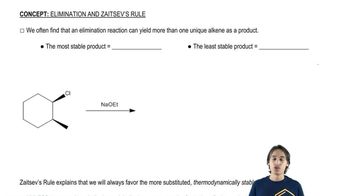For each of the following alkyl halides, indicate the stereoisomer that would be obtained in greatest yield in an E2 reaction.
a. 3-bromo-2,2,3-trimethylpentane

 Verified step by step guidance
Verified step by step guidance Verified video answer for a similar problem:
Verified video answer for a similar problem:



 1:18m
1:18mMaster Defining Zaitsev’s Rule with a bite sized video explanation from Johnny
Start learning